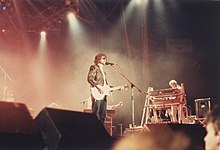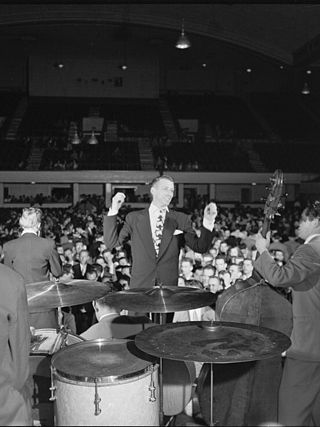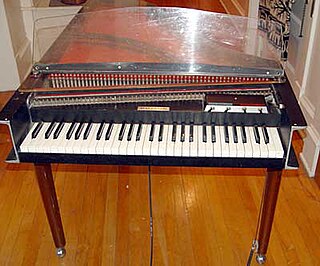Evolution and popularity
1960s: Origins

During the mid 1960s, pop music made repeated forays into new sounds, styles, and techniques that inspired public discourse among its listeners. The word "progressive" was frequently used, and it was thought that every song and single was to be a "progression" from the last. [19] [nb 3] The Beach Boys and the Beatles were among the earliest progenitors of progressive pop via albums such as Pet Sounds and Sgt. Pepper's, respectively. [4] Author Bill Martin recognises the bands as the most significant contributors to the development of progressive rock, transforming rock from dance music into music that was made for listening to. [22] [nb 4] Before the progressive pop of the late 1960s, performers were typically unable to decide on the artistic content of their music. [24] The Beach Boys' leader Brian Wilson is credited for setting a precedent that allowed bands and artists to enter a recording studio and act as their own producers. [25]
Citing a quantitative study of tempos in music from the era, musicologist Walter Everett identifies the Beatles' 1965 album Rubber Soul as a work that was "made more to be thought about than danced to", and an album that "began a far-reaching trend" in its slowing-down of the tempos typically used in pop and rock music. [26] In mid-1966, the UK release of the Beach Boys' Pet Sounds was accompanied by advertisements in the local music press saying that it was "The Most Progressive Pop Album Ever!" [27] Cleveland 's Troy Smith believes that the album "established the group as forefathers of progressive pop, right from the beginning chords of 'Wouldn't It Be Nice', a Wall of Sound style single". [28] [nb 5] In October, Pet Sounds was followed by the psychedelic and elaborately arranged single "Good Vibrations". According to Reed, the song became the "most obvious starting point" in the genre. [4]
The Beatles' Paul McCartney intimated in 1967: "we [the band] got a bit bored with 12 bars all the time, so we tried to get into something else. Then came [Bob] Dylan, the Who, and the Beach Boys. ... We're all trying to do vaguely the same kind of thing." [30] In the opinion of author Simon Philo, the Beatles' progressive pop was exemplified in the double A-sided single "Strawberry Fields Forever" / "Penny Lane" (1967). [31] In a further example of the reciprocal influences between themselves and the Beach Boys, the Beatles demonstrated "paradoxical lyrical content matched by music that was at once 'young' and 'old', rock and Tin Pan Alley, LSD and cocoa, progressive and nostalgic" – all features that were shared on Sgt. Pepper's. [31] Musicologist Allan Moore writes: "At that time, Sgt. Pepper seemed to mark rock music's coming of age ... Now, of course, with jaded memories, we think of it as ushering in an era of pomposity, with varying degrees of seriousness ... The question after 1967 was whether 'progressive' pop/rock was to be trusted, because it was dealing with issues 'deeper' than simply interpersonal relationships. In the long run, the answer turned out to be 'no' (at least, that is, until a later generation of bands discovered the delight of pastiching the Beatles)." [32]
Towards the end of the 1960s, progressive pop music was received with doubt [33] and disinterest. [34] The Who's Pete Townshend reflected that "a lot of psychedelic bullshit was going on", referring to "garbage" being promoted in the charts, and that many artists who were doing ambitious works were instantly being labelled "pretentious". He believed: "Anybody that was any good ... was more or less becoming insignificant again." [35] In 1969, writer Nik Cohn reported that the pop music industry had been split "roughly eighty percent ugly and twenty percent idealist", with the eighty percent being "mainline pop" and the twenty percent being "progressive pop [developed to] an esoteric feel". He predicted that in ten years, the genre would be called by another name (possibly "electric music"), and that its relationship to pop music would be similar to the one between art movies and Hollywood. [36] While progressive pop did not "shrink to a minority cult", as Cohn wrote one year later, "in England, I wasn't entirely wrong ... But, in America, I fluffed completely – the Woodstock nation has kept growing and, for all his seriousness and pretensions to poetry, someone like James Taylor has achieved the same mass appeal as earlier stars." [37]
1970s

Progressive rock (also known as art rock) was ushered in the 1970s, directly following the combination of classical grandiosity and pop experimentalism from the 1960s. [9] Although it reached widespread popularity, from 1975 onward, the genre declined in sales and was played with less frequency on FM radio. [38] According to Breithaupt and Breithaupt, this created a vacuum for "a host of new, milder 'serious' bands, whose humor (Queen), pop smarts (Supertramp), and style (Roxy Music, mach two) would ensure their survival into the eighties. ... they met the melodic requirements of AM radio while still producing thoughtful, original work." [16] Bands like Queen and Electric Light Orchestra (ELO) played a type of progressive pop that was grounded in prog-rock without compromising their chart success. [39] Reed cited ELO's "Mr. Blue Sky" as the "definitive statement" by ELO's Jeff Lynne, who "infus[ed] the Beatles’ kaleidoscopic post-Peppers sing-alongs with symphonic grandeur." [4] [nb 6]
The Buggles' Geoff Downes, who considered his band to be a continuation of ELO and 10cc's progressive traditions, says: "Those early 10cc records such as [1973 debut] 10cc and Sheet Music were pretty out there, and Godley & Creme took that even further. Even ABBA had sections in their music that were quite intricate. We loved all that studio trickery and experimentation. Parallel to that were bands like Yes, who were experimenting in the studio in a more progressive rock format." [42] Porcupine Tree founder Steven Wilson opined that there were "hugely ambitious" progressive pop records in the 1970s and 1980s that were "quite accessible on the surface, but if you [chose] to engage with them on a deeper level, you [could] find layers in the production, musicianship and some thoughtful lyrics." [43]
1980s–2010s
Prog-pop records sold poorly and appeared unfashionable following the emergence of new wave and punk rock. [4] By the late 1970s, the era of record labels investing in their artists, giving them freedom to experiment and limited control over their content and marketing had ended. [44] Corporate artists and repertoire staff began exerting an increasing amount of control over the creative process that had previously belonged to the artists. [45] Some of the major progressive bands transitioned to a more commercial sound and deemphasized the evocation of art music. By the early 1980s, the prevailing view was that the prog-rock style had ceased to exist. [46]
Some mainstream pop acts, such as Tears for Fears, continued the traditions of prog-pop. [4] In 1985, Simon Reynolds noted that the New Pop movement attempted to "bridge" the divide between "progressive" pop and its mass/chart counterpart, describing their general relationship as "one between boys and girls, middle-class and working-class." [3] In 2008, The New York Times ' John Wray discussed "the return of the one-man band", observing a recent progressive pop trend that involved large bands or collectives "with a disdain for clearly defined hierarchies", noting examples such as Arcade Fire, Broken Social Scene, and Animal Collective. [47]








